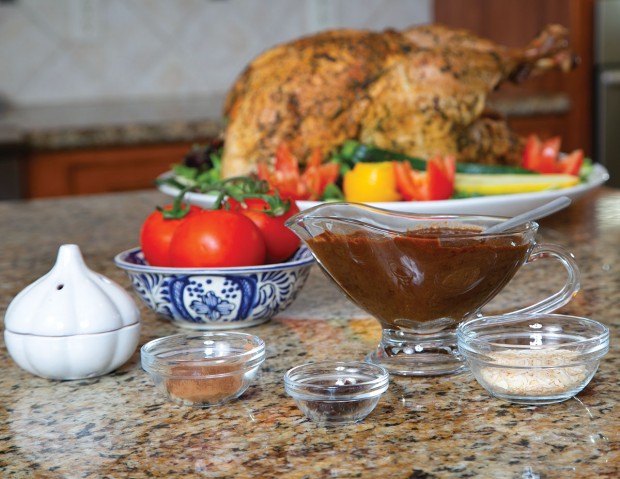Thanksgiving Traditions
Immigrant families blend cuisines

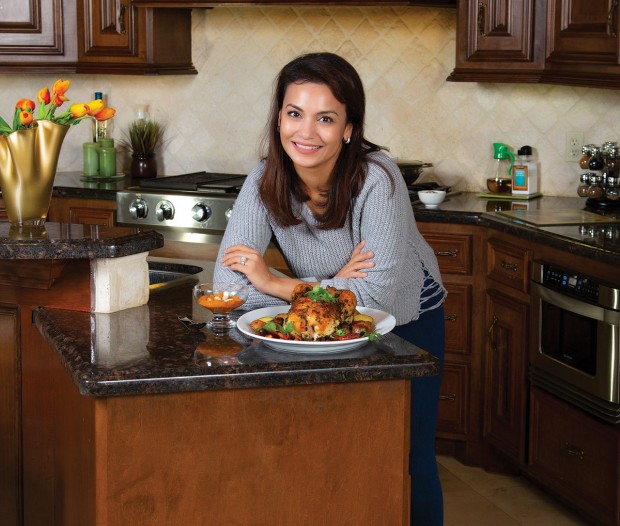
Puja D. hosts Thanksgiving at her Bellaire home, offering a parallel Indian dish for every American Thanksgiving staple. She usually makes tandoori chicken instead of turkey. (Photo: lawellphoto.com)
When Puja D. immigrated from Bombay to Houston at age 25, her only glimpse into Thanksgiving had been through sitcoms like Friends. She’d never carved a Thanksgiving turkey, never entered a food-coma brought on by endless potatoes, stuffing and pie, nor had she known the annual end-of-November ritual that often ends in plopping on the couch with family to watch (American) football.
But 10 years after immigrating to the States as a graduate student, Puja’s first daughter was born in 2015, and Puja adopted Thanksgiving as her own, starting a tradition of hosting the dinner in her Bellaire home for her extended family in greater Houston.
“When I had [my first daughter], I realized I wanted to do something as a tradition for my family,” Puja said. “So, I decided to do my own Indian version of Thanksgiving. Last year, my second baby was only a few months old, and I still hosted it. It’s my joy.”
Puja’s dinner isn’t your typical Thanksgiving fare. Instead, she offers a parallel Indian dish for every traditional American Thanksgiving staple. Instead of turkey, for instance, Puja prepares a tandoori chicken, marinated in a paste of Indian masalas and stuffed with garlic and ginger. For the stuffing, Puja makes paneer bhurji, a popular Indian cottage-cheese dish that’s a favorite among many kids. Her Indian salad includes chopped up cucumbers and tomatoes tossed in cumin powder and masala. She makes one of two Indian green bean side dishes as well as pulao, a mildly spiced rice dish, and parathas, an Indian stuffed flatbread.
“All of this can be done the same day,” Puja says. “I do the prep work one day in advance but everything else the day of.”
Puja’s family members try to help her by bringing over a pie or other American desserts. But, Puja says, those are often left untouched, because everyone opts for her pumpkin halwa, a dessert with grated pumpkin, ghee, cardamom, cashew nuts and milk.
After eating dinner around 4 p.m., the entire crew – about 16 of them – heads over to the Galleria area for the holiday lighting and fireworks. Puja and her husband were married over Thanksgiving weekend, so the evening turns into an anniversary celebration as well.
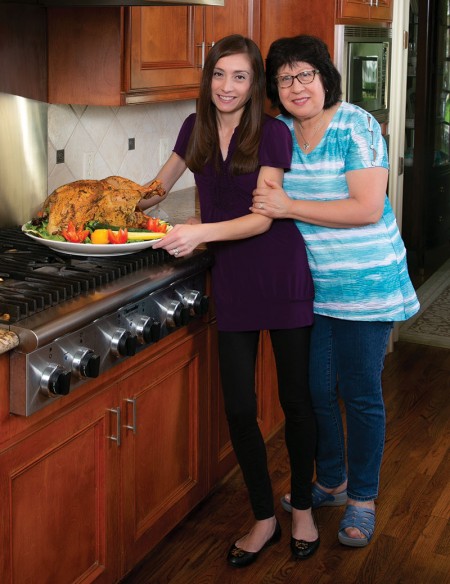
Daughter Maryann Lio Grahmann (at left) grew up celebrating Thanksgiving with Mexican dishes made by her mom Maria Lio (at right). The family continues that tradition with Maryann’s children. (Photo: lawellphoto.com)
Maryann Lio Grahmann’s family similarly brings their cultural background to create a multicultural Thanksgiving dinner. Maryann’s mother, Maria Lio, was born and raised in Mexico City. She immigrated to the States with her husband and two daughters in 1987, settling in McAllen, Texas, a stone’s throw from the Mexican border.
Growing up, Maryann recalls crossing the U.S.-Mexico border frequently for meals or to visit extended family. But even when they remained in Texas, Maria found ways to bring a Mexican influence to American food, especially during the holiday season. On Thanksgiving, Maria “will cook a turkey like everybody else, but instead of dressing it with gravy, she’ll make a mole sauce,” Maryann says of her mom. “And instead of rolls, we’ll have tortillas.”
Maria has continued this tradition, and every other year, Maryann and her family – husband Kraig, 5-year-old son Mason and twins Michael and Mari – drive from West U over to Maria’s house for Thanksgiving dinner. Maria and her husband Robert recently moved from McAllen to Pearland to be closer to Maryann and her family.
Maryann shows up at her parents’ house with her family about an hour before Thanksgiving dinner. By this time, Maria has already prepped all of the dishes and is keeping them warm in the oven until the family arrives. “We might bring a dish or two, but really it’s my mom,” Maryann says. “It’s a labor of love for her. She’ll get up really early and make all of the dishes.” After enjoying mole-topped turkey, tortillas, vegetables and Mexican rice, everyone enjoys a healthy slice of both pumpkin pie and Mexican flan.
Maryann’s kids love the tradition, especially her eldest son Mason who is always excited for Mexican food. “My kids kind of live in two worlds,” says Maryann. “Thanksgiving is cool because it’s a blending of the two worlds.”
When her kids are older, Maryann wants to start hosting Thanksgiving at her own home. “I’d love to continue the blending. I speak to all my kids in Spanish. I very much want them to be aware of their cultural background,” Maryann says.
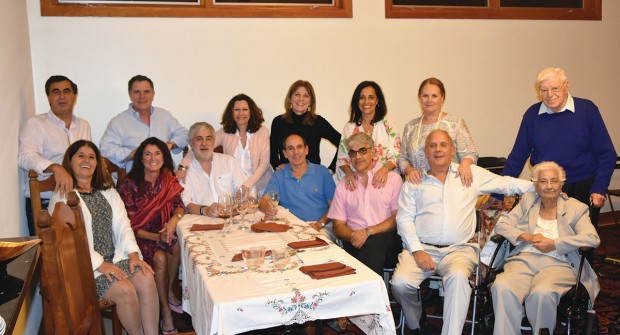
The Gras family brings their Argentinean culture to the Thanksgiving meal they host every year. Pictured here at their 2015 celebration are (from left) Cecilia and Miguel Di Vincenzo, Rita and German Cura, Ana and Gustavo Scuseria, Graciela and Juan Mayorga, Sonia and Richard Gras, Yemi and Eduardo Beltramini, and Salome and Hector Gras.
For the Gras family, Thanksgiving is an opportunity to get together with a group of about 40-60 Argentinians for food, fútbol and friends.
“We usually do Thanksgiving lunch with all our Argentine family friends because in Argentina, celebratory meals can last hours and hours, so lunch bleeds into dinner,” says Nicole Gras, whose parents Sonia and Richard are both Argentinian and live in Bellaire.
The Gras family – including children Nicole, 27, Alexander, 29, Andre, 24, and Sean Paul, 20 – hosts Thanksgiving every year, spending the day before the big day clearing out space in their house to accommodate the large group of what Andre calls “people who over time we call cousins, but they aren’t really.”
The meal does include American dishes such as the Thanksgiving turkey, casseroles and yams with marshmallows, and the TV is often flipped to ESPN, as with millions of American families across the country. But the Gras family marries Argentinian culture with American tradition, always making Sonia’s homemade meat empanadas and welcoming different types of Argentinean desserts such as pasta flora, alfajores and panqueques de dulce de leche, from guests. Outside, many guests are playing soccer, the most popular sport in Argentina, even while American football is playing on the television.
In melding Argentinian culture with the American tradition of Thanksgiving, the Gras family has not lost sight of the meaning behind the national holiday. Before carving the turkey, everyone gathers around the table and takes turns saying thanks. “Since most of the people who come are Argentines who immigrated to the States and their kids, our Thanksgiving is centered around being grateful for the opportunities we have been given in this country and being thankful for finding such a strong community of Argentines in Houston to help each other with the challenges that immigrants face,” says Nicole.
“At the end of the day, it’s a time to get together with family and friends and celebrate,” Andre adds.
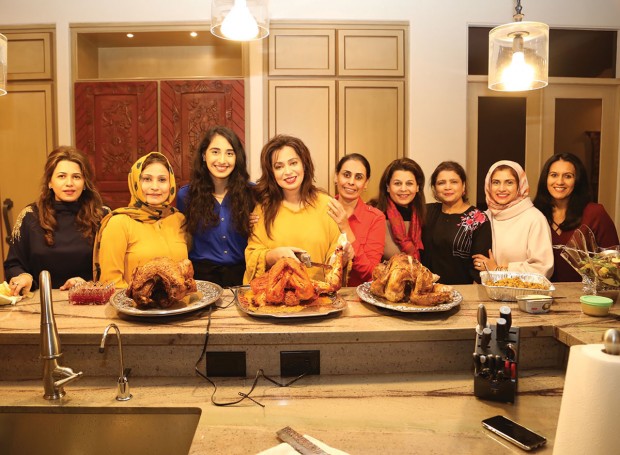
GIVING THANKS Tehmina Masud (fifth from left) celebrates Thanksgiving with Pakistani family friends in Houston, (from left) Farah Hashmi, Shenila Cochinwala, Madiha Faisal, Romana Bano Raheem, Sarah Zaidi, Huma Iftikhar, Aliya Hussain and Fauzia Zamir. (Photo: Dr. Irfan Iftikhar)
While families like Nicole’s, Maryann’s and Puja’s have integrated their traditional cuisines into Thanksgiving dinner, other immigrant families have developed a taste for American cooking. Tehmina Masud, an immigrant from Pakistan, spends Thanksgiving with a group of about six Pakistani families each year. Each family prepares a dish – Tehmina is usually assigned the green beans – and goes over to one person’s house, usually Aliya and Ayub Hussain’s place in Memorial.
“We have the beans, potatoes, cranberry sauce, turkey, buns baked fresh, pudding – the menu is a complete Thanksgiving menu,” says Tehmina.
The one non-traditional item on the menu is a Pakistani-style chicken that the host always makes just for Tehmina, who admits she’s not too fond of turkey. Aliya bakes the chicken with minced garlic, smoked paprika, olive oil and thyme. “Everyone laughs because I’m a complete Pakistani food lover,” Tehmina says. “But my kids love the American Thanksgiving menu, I think because they have eaten Desi food every day of their lives.”
Tehmina says she does not know how to cook American food, so her three daughters usually help her out with the green beans, one daughter finding the recipe, one buying the ingredients and one helping her cook them. The joint cooking effort has become a family ritual, after the family runs the BakerRipley Turkey Trot near the Galleria on Thanksgiving morning.
Though this Thanksgiving tradition started more than a decade ago, Tehmina has not always celebrated the American holiday. Tehmina moved to the United States with her husband Faisal, who was pursuing his residency at Johns Hopkins University at the time. When fall rolled around and people started talking about their Thanksgiving plans, Tehmina did not know what she was supposed to do.
“First, I didn’t know if it was religious or cultural,” Tehmina says. “I was a little protective. If it was a religious thing, I wondered, should I be doing this? Is this a conflict with the religious practice I do?”
Tehmina practices Islam and later learned from two Christian friends that Thanksgiving is not tied to any particular religion. Still, it took her several years to develop a Thanksgiving tradition of her own. Before moving to Houston in 1997, Tehmina and her family lived in D.C. and Cleveland, where they would sometimes celebrate Thanksgiving with extended family, but not to the extent they do now.
In Houston, the Masuds gained a greater appreciation of Thanksgiving. When her daughters were students at Memorial Middle School, Tehmina attended the fall harvest festival, where a family would decorate their home with a Thanksgiving theme and invite families and students to visit for an open house.
“It was very educational for me,” Tehmina says. “I remember there was a turkey and pumpkins all over the house. I became fascinated by how enriched the culture was.”
Tehmina also appreciated the idea of sitting around the dinner table with friends to give thanks. Now, it’s a tradition for each person at Thanksgiving dinner to share what they are most thankful for from the previous year.
“Each religion has their own forms of expressing thanks,” Tehmina says. “Yet I feel that Thanksgiving really puts the reason to be thankful out in a beautiful way of sitting down at the table and talking about it. It’s not whether you’re a Muslim, or a Jew or a Christian, you’re just expressing thanks.”
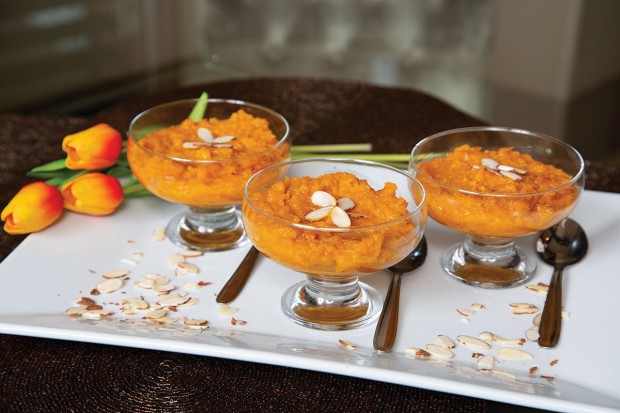
For dessert, Puja makes pumpkin halwa using grated pumpkin, ghee, cardamom, cashew nuts and milk. (Photo: lawellphoto.com)
Puja D.’s Pumpkin Halwa
1 Tablespoon ghee or unsalted butter
2 cups grated pumpkin
2 Tablespoons milk
¼ cup, plus 4 Tablespoons sugar
1/8 teaspoon ground cardamom
Melt the ghee or butter in a medium skillet over a medium heat. Add the grated pumpkin. Cook for a few minutes, stirring now and then until it has softened. Don't rush this bit; you should see it change color.
Add the milk and stir it in so that it is absorbed. Then add the sugar and cardamom. Stir in and cook for a few minutes until glossy-looking but not wet. You can also make it more of a puree by adding a little more milk, covering and steaming a few minutes and then mashing before adding sugar etc. Serve it hot or chilled.
Sonia Gras’ Empanadas de Carne (meat empanadas) 2 Tablespoons oil
2 pounds white onion, finely chopped
2 pounds ground meat
Salt and pepper to taste
1 cube beef bouillon
1 Tablespoon paprika
3 packages dough for turnover pastries
1 bunch green onion, finely chopped
2 hard-boiled eggs, chopped
Heat oil in skillet, add white onions and cook at medium temperature until onions are translucent. Add ground meat and cook. Season with salt and pepper to taste. Then dissolve a cube of beef bouillon in ½ cup of boiling water and add paprika. Mix well with meat and onion. Let the preparation chill in the refrigerator.
When the meat mix is chilled, put some on a center of a disc of dough and add 1 teaspoon of chopped green onion and boiled eggs. Close the dough. In Argentina, this process is called “repulgo” or “repulgue,” but you can close by using a fork to press. Preheat oven to 460 degrees. Spray oil on an oven pan and place empanadas on it. Bake until golden brown.
(The best dough to use to prepare empanadas in Houston is called La Saltena. You can find it at Fiesta or Phoenicia Specialty Foods. If you cannot find it, then use Goya.)
Maria Lio’s Mole Negro 2 small tomatoes
1 white onion, cut into thick slices
1 small garlic clove
1 jar Doña Maria mole paste (8.25 oz)
4-5 cups chicken broth
¼ teaspoon ground cinnamon
¼ teaspoon ground anise seed
Place the tomatoes, onion and garlic in a saucepan. Cover with water and turn heat to medium/high. Once it reaches a roiling boil, reduce heat and cook for 8 minutes, or until the tomatoes are cooked. Drain water and place tomatoes, onion and garlic into blender. Blend until you have a fine sauce; set aside.
Place a large frying pan over low-heat and add the jar of mole paste and a cup of the chicken broth. Start diluting the paste. Add one or more cup(s) of chicken broth along with the tomato sauce mixture, ground cinnamon and ground anise seed. Stir well until the mole paste dissolves completely. The sauce will thicken as it continues cooking, so add more broth as needed. Traditional mole sauce has the consistency of thick gravy.
Aliya Hussain’s Paprika Chicken 1 whole chicken with skin
4 cloves garlic, minced
1 Tablespoon smoked paprika
½ Tablespoon hot paprika
1 Thyme twig
2 Tablespoons olive oil
Preheat oven to 500 degrees. Mix oil with all spices (except thyme). Apply on chicken, including between skin and meat. Place thyme twig in chicken cavity. Bake for 30 minutes at 500 degrees. Lower oven to 350 degrees and continue to cook for another 30-45 minutes (until golden brown).
Want more buzz like this? Sign up for our Morning Buzz emails.
To leave a comment, please log in or create an account with The Buzz Magazines, Disqus, Facebook, or Twitter. Or you may post as a guest.


